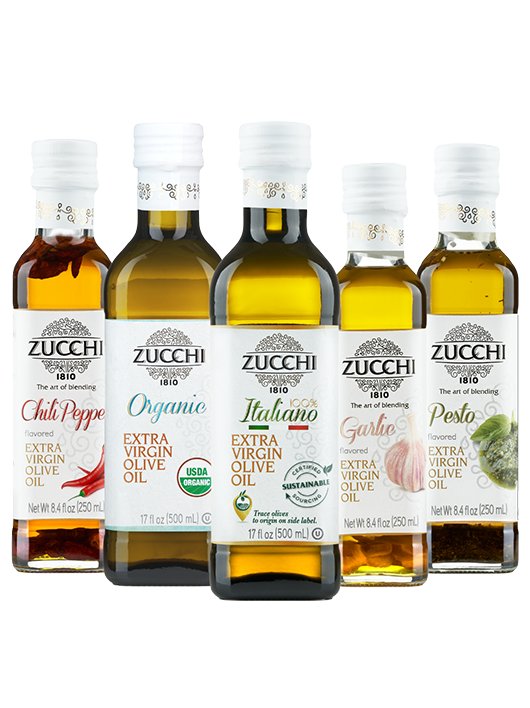3 Rules for Pairing Olive Oil With Food
Discover our three basic rules for pairing olive oil with food.
May 5, 2021

Discover our three basic rules for pairing olive oil with food.
May 5, 2021
You pair wine with your dinner all the time, but have you ever thought about pairing olive oil with food?
In the same way that a Pinot Grigio complements that halibut on your plate, so, too, does extra virgin olive oil work to create balance and harmony.
So how do you know which olive oils to pair with what? While there are no set in stone rules, these three guidelines can help you understand how to better use olive oil in your culinary creations.
The first step in pairing olive oil with food is to understand the intensity of the oil and of the dish you are preparing.
In general, extra virgin olive oils will fall into the following categories of intensity: mild, medium, or robust.
Mild olive oils have a delicate, buttery, or floral taste, with a light peppery finish.
Medium olive oils are bitter and pungent but aren’t too overpowering in flavor. They may have a light peppery finish.
Robust olive oils have an intense and bold taste, often with a strong peppery finish.
In the same ways that olive oils have different intensities, so too does your dish! Before pairing olive oil with food, you should ask yourself what kind of intensity the dish has. Is it a delicate, buttery dish? Or are you cooking up a hearty beef roast with lots of intense garlic? The more you practice thinking about this, the better you’ll get at identifying dish intensities.
When it comes to pairing olive oil with food, it’s important to ask yourself: do I want to complement or contrast?
A complementing olive oil offers a balancing intensity and flavor. For example, if you are cooking a robust-flavored dish, such as a lamb stew, consider using a robust extra virgin olive oil. On the other hand, if you’re mixing up a light salad with tender, buttery greens and burrata cheese, you should stick to a mild olive oil so as not to overpower the delicate flavors in your salad.
A contrasting olive oil offers the opposite: it offers variance and distinction. Let’s say you’re preparing a dish that has strong flavors, like smoked trout. Since the fish, in this case, has an intense flavor, you may want to stick with a delicate and mild olive oil so that you don’t overpower the star of the dish.
Ultimately, it’s up to you, as the chef, to decide how you want the flavors to play out on the dish.
When in doubt, remember: what grows together, goes together. An extra virgin olive oil made from olives grown in Puglia will go well with typical Pugliese dishes. On the other hand, olive oil made from olives grown in Tuscany is bound to pair superbly with dishes from the surrounding region.
Of course, this isn’t a hard-and-fast rule. Olive oil from Greece, for example, may very well pair fantastically with an Italian dish! Nevertheless, pairing olive oils with recipes from the same origin region is a good starting point and you really can’t go wrong.

Ready to bring sustainable Italian culinary tradition into your kitchen? Shop Zucchi in a store near you.
Get olive oil recipes, tips, and Zucchi promotions delivered straight to your inbox.
